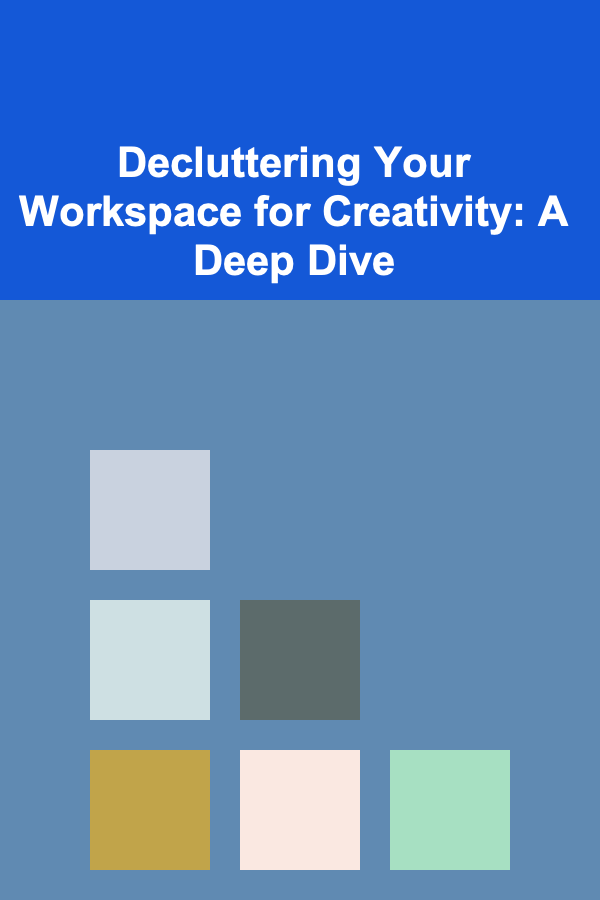
Decluttering Your Workspace for Creativity: A Deep Dive
ebook include PDF & Audio bundle (Micro Guide)
$12.99$10.99
Limited Time Offer! Order within the next:

In the realm of creativity, inspiration often feels elusive, a capricious muse that visits on her own terms. However, while we cannot force creativity, we can cultivate an environment conducive to its blossoming. One of the most potent, yet often overlooked, methods for fostering creativity is decluttering your workspace. A clean and organized workspace isn't just about aesthetics; it's about mental clarity, focus, and ultimately, unlocking your creative potential.
The Psychology of Clutter: How Chaos Stifles Creativity
Before delving into the practical steps of decluttering, it's crucial to understand the profound psychological impact of clutter. Our brains are wired to process information efficiently, and a cluttered environment creates a constant barrage of visual and mental noise. This overload has several detrimental effects on creativity:
- Cognitive Overload: Clutter competes for our attention, forcing our brains to work harder to filter out irrelevant stimuli. This cognitive overload depletes our mental resources, leaving less energy for creative thinking. It's like trying to listen to a delicate melody in the middle of a noisy construction site.
- Increased Stress and Anxiety: Studies have shown a direct correlation between clutter and increased levels of stress hormones like cortisol. A messy workspace can trigger feelings of overwhelm, anxiety, and even guilt ("I should be more organized!"). These negative emotions are antithetical to the relaxed, open state of mind that fosters creativity.
- Reduced Focus and Concentration: A cluttered desk is a constant distraction. Our eyes and minds are drawn to the various objects vying for our attention, making it difficult to stay focused on the task at hand. This fragmented attention hinders deep thinking and inhibits the flow of ideas.
- Impaired Decision-Making: The constant visual stimulation of clutter can make it harder to make decisions, even simple ones. This decision fatigue can further drain our mental energy and stifle creative problem-solving.
- Suppressed Motivation: A disorganized and overwhelming workspace can be incredibly demotivating. It can feel like an insurmountable task just to sit down and start working. This lack of motivation can lead to procrastination and ultimately, hinder creative output.
In contrast, a clean and organized workspace provides a sense of calm and control. It signals to your brain that you are in a structured and manageable environment, which reduces stress and allows you to focus on your creative endeavors.
The Decluttering Process: A Step-by-Step Guide
Decluttering can feel like a daunting task, but by breaking it down into manageable steps, you can make the process less overwhelming and more rewarding. Here's a comprehensive guide to decluttering your workspace for creativity:
1. Define Your Ideal Creative Workspace
Before you start throwing things away, take a moment to visualize your ideal creative workspace. What does it look like? How does it feel? Consider the following questions:
- What activities will you be performing in this space? (Writing, painting, coding, designing, etc.)
- What tools and materials do you need readily accessible?
- What kind of atmosphere do you want to create? (Calm and serene, energetic and vibrant, etc.)
- What are your biggest distractions in your current workspace?
- What elements would inspire you and spark your creativity?
Creating a mental image of your ideal workspace will help you make informed decisions about what to keep, what to discard, and how to organize the remaining items.
2. The Four-Box Method: Sorting and Categorizing
The four-box method is a simple yet effective way to sort through your belongings and make decisions about their fate. You'll need four boxes (or designated areas):
- Keep: Items you use regularly and that directly contribute to your creative process.
- Donate/Sell: Items you no longer need or use but are still in good condition.
- Trash: Items that are broken, damaged, or no longer usable.
- Relocate: Items that don't belong in your workspace but are still useful and needed elsewhere.
Go through every item in your workspace, one by one, and place it in the appropriate box. Be honest with yourself about what you truly need and use. Don't let sentimental attachments cloud your judgment. Ask yourself: "Have I used this in the last six months? If not, is there a compelling reason to keep it?"
3. The Purge: Letting Go of the Excess
This is the most challenging but also the most liberating part of the process. It's time to ruthlessly eliminate the excess clutter that is hindering your creativity. Here are some tips for letting go:
- Embrace Minimalism: Remember that owning less stuff can actually enhance your life by freeing up your time, energy, and mental space.
- Focus on Functionality: Only keep items that serve a practical purpose and contribute to your creative workflow.
- Question Your Sentiments: It's okay to have sentimental attachments to certain objects, but don't let them clutter your workspace. Consider taking a photo of the item and then donating or discarding it.
- The "One In, One Out" Rule: For every new item you bring into your workspace, get rid of one old item. This will help prevent future clutter buildup.
- Start Small: If you're feeling overwhelmed, start by decluttering one small area, such as a drawer or a shelf. The sense of accomplishment will motivate you to continue.
Be decisive and don't second-guess yourself too much. Trust your initial instincts about what to keep and what to discard.
4. Organizing What's Left: Creating a System that Works
Once you've purged the excess, it's time to organize the remaining items in a way that promotes efficiency and creativity. Here are some organizational strategies to consider:
- Vertical Storage: Utilize vertical space to maximize storage. Use shelves, wall-mounted organizers, and hanging containers to keep items off your desk.
- Clear Containers: Use clear containers to store supplies so you can easily see what's inside. Label each container clearly.
- Designated Zones: Create designated zones for different activities, such as writing, painting, or brainstorming. Keep the tools and materials you need for each activity within that zone.
- Ergonomics: Arrange your workspace to promote good posture and reduce strain. Make sure your chair is comfortable and supportive, and that your computer screen is at eye level.
- Digital Declutter: Don't forget to declutter your digital workspace as well. Organize your files, delete unnecessary documents, and unsubscribe from unwanted emails.
- Prioritize Accessibility: Keep frequently used items within easy reach. Store less frequently used items in less accessible locations.
The key to successful organization is to create a system that works for you. Experiment with different layouts and storage solutions until you find a system that is both functional and aesthetically pleasing.
5. Maintaining Your Clutter-Free Workspace: Habits for Long-Term Success
Decluttering is not a one-time event; it's an ongoing process. To maintain a clutter-free workspace and reap the long-term benefits for your creativity, it's essential to develop good habits:
- Daily Tidy-Up: Spend just a few minutes each day tidying up your workspace. Put away any items you've used, wipe down surfaces, and throw away any trash.
- Regular Purging: Schedule regular decluttering sessions (e.g., once a month or once a quarter) to prevent clutter from building up again.
- The "One-Minute Rule": If a task takes less than a minute to complete, do it immediately. This will prevent small tasks from piling up and becoming overwhelming.
- Mindful Consumption: Be mindful of what you bring into your workspace. Before buying something new, ask yourself if you really need it and where you will store it.
- Embrace the "Just In Case" Mentality, But Strategically: We all have items we keep "just in case." Evaluate these critically. Consider if a digital version exists, or if the item can be borrowed or easily replaced if truly needed. For those kept, ensure they are properly stored and organized, not cluttering your primary workspace.
By incorporating these habits into your daily routine, you can create a sustainable system for maintaining a clutter-free workspace and fostering your creativity.
Beyond the Physical: Mental Decluttering for Enhanced Creativity
While physical decluttering is essential, it's equally important to declutter your mental space. Mental clutter, such as negative thoughts, limiting beliefs, and unresolved issues, can be just as detrimental to creativity as physical clutter. Here are some techniques for mental decluttering:
- Meditation and Mindfulness: Practicing meditation and mindfulness can help you quiet your mind, reduce stress, and increase your awareness of your thoughts and feelings.
- Journaling: Writing down your thoughts and feelings can help you process them and release negative emotions. Use a journal to explore your creative ideas, brainstorm solutions, and track your progress.
- Setting Boundaries: Learn to say no to commitments and obligations that drain your energy and distract you from your creative goals.
- Time Management: Effectively managing your time can reduce stress and create more space for creative pursuits. Prioritize your tasks, break down large projects into smaller steps, and avoid procrastination.
- Positive Affirmations: Replace negative thoughts with positive affirmations that reinforce your creative abilities and potential.
- Unplugging from Technology: Take regular breaks from technology to disconnect from the constant stream of information and allow your mind to rest and recharge.
By combining physical and mental decluttering, you can create a holistic environment that supports your creativity and allows you to thrive.
The Benefits of a Decluttered Workspace: Unlocking Your Creative Potential
The benefits of decluttering your workspace extend far beyond mere aesthetics. A clean and organized workspace can have a profound impact on your creativity, productivity, and overall well-being. Here are some of the key benefits:
- Increased Focus and Concentration: A clutter-free workspace eliminates distractions and allows you to focus on the task at hand.
- Reduced Stress and Anxiety: A clean and organized environment promotes a sense of calm and control, reducing stress and anxiety.
- Enhanced Creativity and Inspiration: A clutter-free mind is more open to new ideas and possibilities. A well-organized space can also be visually stimulating and inspiring.
- Improved Productivity and Efficiency: A decluttered workspace allows you to find things quickly and easily, saving you time and effort.
- Greater Motivation and Enthusiasm: A clean and inviting workspace can make you feel more motivated to work and pursue your creative goals.
- Better Overall Well-being: A decluttered workspace can contribute to a sense of peace, order, and well-being, leading to a happier and more fulfilling life.
Conclusion: Embrace the Power of Decluttering for a More Creative Life
Decluttering your workspace is not just about tidying up; it's about creating a nurturing environment that supports your creativity and allows you to reach your full potential. By understanding the psychology of clutter, following a step-by-step decluttering process, and developing good maintenance habits, you can transform your workspace into a haven of inspiration and productivity.
Embrace the power of decluttering and unlock the creative potential that lies within you. Start today, and you'll be amazed at the difference it can make.
Reading More From Our Other Websites
- [Personal Care Tips 101] How to Create a Relaxing Bedtime Routine for Kids
- [Organization Tip 101] How to Keep Pets and Their Items Organized During Showings
- [Reading Habit Tip 101] Unlocking the Secrets: Proven Strategies to Boost Reading Comprehension
- [Sewing Tip 101] Eco‑Friendly Sewing: Sustainable Thread Options for Green Crafters
- [Soap Making Tip 101] Seasonal Scents: Using Lavender, Rosemary, and Mint in Homemade Soaps
- [Home Lighting 101] How to Incorporate Vintage Lighting Fixtures into Your Decor
- [Personal Care Tips 101] How to Create a Fresh, Everyday Makeup Look with Blush
- [Polymer Clay Modeling Tip 101] Budget‑Friendly Polymer Clay Projects for Kids and Adults Alike
- [Personal Care Tips 101] How to Achieve a Restful Sleep Through Personal Care
- [Home Storage Solution 101] How to Maximize Closet Space with Clever Storage Solutions

How to Build a Checklist for Selecting the Right Migration Tools for Your Website
Read More
How to Hire Professional Home Cleaning Services: What to Expect
Read More
How to Plan Meaningful Activities with Your Family
Read More
How to Renovate Your Home While Living in It
Read More
How to Understand the History of Graphic Design
Read More
10 Tips for a Sustainable Fitness To-Do List
Read MoreOther Products

How to Build a Checklist for Selecting the Right Migration Tools for Your Website
Read More
How to Hire Professional Home Cleaning Services: What to Expect
Read More
How to Plan Meaningful Activities with Your Family
Read More
How to Renovate Your Home While Living in It
Read More
How to Understand the History of Graphic Design
Read More